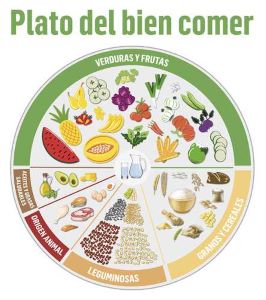Mexican 2023 Dietary Guidelines Recommend that 92% of our Plate Be Plant Foods!
By Odette Olivares, MSN, VRG volunteer
Mexican dietary guidelines were updated on May 22, 2023.1,2 The new version of the Healthy Eating Plate recommends increasing the consumption of plant foods to 92% of our plates and supports exclusive breastfeeding for babies until 6 months of age. Natural, unrefined, seasonal, and local foods products are now stressed.
Fruits and vegetables increased to 50% of the recommended plate; previously these foods were 30% of the plate. Grains and cereals decreased from 30% to 22% of the plate. Legumes were separated from the previous “Legumes and Foods of Animal Origin” category and now have their own category, covering 15% of the plate. Foods of Animal Origin were reduced to only 8% of the plate. Healthy fats and oils were added and now account for 5% of the new plate.
Water is included at the center of the plate. Alcohol consumption is not recommended at all for the sake of our mental and physical health, and the well-being of our families. Interestingly, the plate also stresses the need for a shift in food systems to tackle malnutrition and improve human and planetary health, an aspect that is usually not included in Dietary Guidelines and is mostly present only in scientific literature.
Ultra-processed foods with octagon seals are strongly not recommended. Octagon seals are part of a Mexican food labeling system. They inform customers with clarity about foods that are high in sodium, sugar, salt, fats, and trans-fats by using black and white octagon shapes. This supports the recent front-of package labeling regulations in Mexico that require food products to state if they contain a high content of trans or saturated fats, sugar, and salt, or if they contain caffeine or artificial sweeteners. Trans fats will be soon forbidden in ultra-processed foods available in Mexico according to Ricardo Cortés, General Director for Health Promotion in Mexico.
The update includes 10 nutritional recommendations that plan to tackle the severe double burden of malnutrition and climate change and protect Mexican biodiversity and traditional gastronomy.
- During the first 6 months of extra-uterine life, babies only need breastfeeding. Afterward, breastfeeding should be complemented with varied and nutritious foods till at least 2 years of age.
- Mexicans should increase their consumption of fresh, seasonal, local, and economic vegetables and fruits in all their meals whenever possible.
- Let’s consume beans, lentils, broad beans, and any other type of legumes daily as stews, soups, or together with vegetables. They are rich in fiber and protein and are practical and cheap.
- We should choose whole cereals such as tortillas, oats, rice, or tubers such as potatoes. They contain vitamins and fiber and provide energy.
- Let’s eat less beef and processed meat. Replacing them with plant proteins such as beans and lentils benefits our health and planetary health.
- Ultra-processed foods such as breakfast cereals, cookies, sweetened bread, and chips have too much sugar, salt, and fat. So, we should choose foods without front-of package octagon seals or those foods with the least number of seals.
- Drinking water instead of sweetened beverages, sodas, juices, sport drinks, or beverages with artificial sweeteners, throughout the day and with all our meals, will help us take care of our health.
- Let’s avoid alcohol consumption for the sake of our physical and mental health, and the well-being of our families.
- Every movement counts! Let’s perform physical activities such as walking, running, or dancing, instead of spending time in front of screens.
- Let’s enjoy meals together with our families and friends whenever possible. We should participate in meal planning and preparation, being mindful of not wasting food.
A multidisciplinary team of experts in nutrition, public health, epidemiology, human behavior, and environment from the Mexican Ministry of Health, UNICEF Mexico, FAO, OPS/OMS, National Institute of Public Health, and other Mexican institutions worked together to create the new version. The scientific base of the new guidelines stems mainly from the scientific article “Food in the Anthropocene: The EAT–Lancet Commission on Healthy Diets from Sustainable Food Systems.”3
The absence of conflicts of interest and interference from the food industry contributed to prioritizing Mexican and planetary health. Mexico now offers an example of one of the best dietary guidelines in the world, according to Simón Barquera, Director of the Mexican Nutrition and Health Research Center of the National Institute of Public Health.
References
- Secretaría de Salud. Guías Alimentarias 2022 para la Población Mexicana. Gobierno de México. May 22, 2023. Accessed May 28, 2023. https://www.gob.mx/cms/uploads/attachment/file/826671/InfografiaGuiasAlimentariasParaPoblacio_n_2023.pdf?fbclid=IwAR3oLzaxW9Y5pL8LFH-j4Gj7z0fR5WEzfzqfQb1Kov84kXqM4IM-w1_86MY.
- Secretaría de Prevención y Promoción a la Salud; 2023. Accessed May 28, 2023. https://www.facebook.com/SaludSPPS/videos/779477700408576.
- Willett W, Rockström J, Loken B, et al. Food in the Anthropocene: The EAT–Lancet Commission on Healthy Diets from Sustainable Food S Lancet. 2019;393(10170):447-492. doi:10.1016/s0140-6736(18)31788-4

